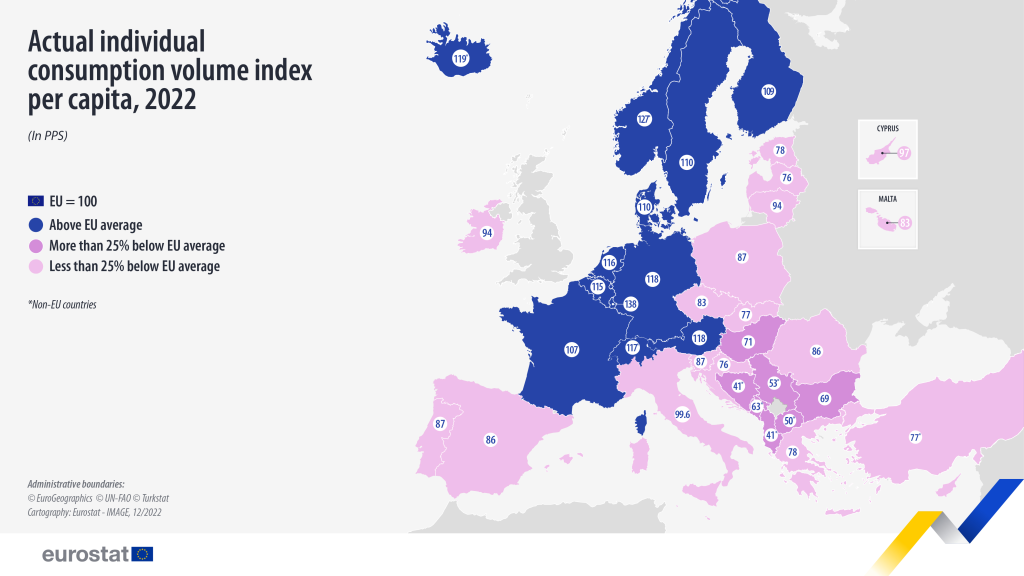December 18, 2023 – As part of the EU, Croatia belongs to one of the most developed parts of the world, but within the EU itself there are big differences between the richest and the less rich. The progress of a country that is less developed than the EU average can be seen by approaching the standard of the EU average, and the regression by moving away from the average. According to the most recent Eurostat data on actual individual consumption, Croatian standard ranks among the lowest in the EU.
As Index writes, poorer countries should progress faster towards the average because they have more significant growth of GDP and standard, i.e. it is easier for them to grow economically at high rates. Less developed EU countries have been approaching the EU average in recent years, as has Croatia.
Actual consumption in Croatia is one of the lowest in the EU
According to actual individual consumption, adjusted for the price difference (PPS), Croatia is one of the EU members with the lowest standard. Only two countries have a lower standard according to this indicator, Hungary and Bulgaria. Croatia is at 76 percent of the EU average according to actual individual consumption, Hungary at 71 percent, and Bulgaria at 69 percent. These are the three EU members whose population has the worst standard.
Actual individual consumption is a measure that refers to all products and services that households actually consume. More specifically, it includes products and services purchased directly by households and services provided by the government (e.g. health and education services).
Slovakia (77 percent), Estonia (78 percent), Greece (78 percent), the Czech Republic (83 percent), Poland (87 percent) and Slovenia (87 percent), among others, are more developed than Croatia. The countries with the highest standard in the EU, measured by actual individual consumption (PPP), are Luxembourg (138 percent), Germany (118 percent), Austria (118 percent) and the Netherlands (116 percent).
Turkey’s Standard Better Than Croatia’s
The situation with non-EU countries is interesting. Norway (127 percent of the EU average) and Iceland (119 percent of the EU average) have a higher standard than all EU members except Luxembourg. Turkey has made strong economic progress in recent decades, so in 2022 it recorded a real individual consumption higher than Croatia, 77 percent of the EU average. That is more than even four EU members.
According to this indicator, the countries of the Western Balkans turn out to be black holes of economic development and standards on the European continent. Montenegro is the most prosperous with 63 percent of the real individual consumption of the EU average, followed by Serbia (53 percent), North Macedonia (50 percent), BiH (41 percent) and Albania (41 percent).
The gap between the listed countries and even the poorest EU countries is too big for them to make up in the near future, especially considering that they generally do not show a strong trend of reaching the EU average standards.

Reaching the EU too slowly, other countries have overtaken Croatia
Croatia is approaching the EU average standard. In 2000 it was 51 percent, in 2008 66 percent, and in 2022 76 percent. Classical convergence, the phenomenon that less developed countries can achieve higher rates of economic growth and approach the average of the developed ones.
However, there are two problems with Croatia’s path towards the EU average. The first is that countries that started from a similar or even lower level of standards progressed much faster, and the second is the fact that in the period from 2008 to 2015, it even moved away from the EU standard average, from 66 percent to 63 percent.
Croatia only returned to the level of 66 percent of the EU average of actual individual consumption in 2018, so this could be considered Croatia’s economically lost decade.
Slower attainment of EU standards and ten-year stagnation have led to the fact that countries that had a lower standard at the beginning of this millennium have become more prosperous to this day.
These are Lithuania, which started with 45 percent of the EU average, and today it is 94 percent. Estonia was at 43, and today it is at 78 percent. Turkey from 43 to 77 percent. Romania had a particularly strong growth in standards, which used to be 21 percentage points behind Croatia, and in 2022 is 10 percentage points ahead.
Disappointing results of the Western Balkans
Of the countries outside the EU, Turkey had the most significant progress, from 43 percent of the EU standard individual consumption average in 2000 to 77 percent in 2022. Serbia progressed from 32 percent to 53 percent, which is less than Croatia, let alone some of the successful countries.
Albania went from 21 percent of the EU average to 41 percent, which is also slow. North Macedonia did not make a significant improvement either, having gone from 35 percent in 2000 to 50 percent in 2022.
BiH is a particular disappointment, for which there have been data only since 2005. That year it was at 37 percent of the EU average measured by real individual consumption, and in 2022 it was at 41 percent. At this rate, it will take the country more than two hundred years to catch up with the EU average.
Croatia has itself to blame for the slow growth of standard
The situation in which Croatia found itself, largely due to its own fault, led to the fact that throughout the 21st century, it was relatively lagging behind similar countries. Other countries simply approached the EU standard faster, even though Croatia had a better initial position.
Romania, once a much less developed country, has overtaken Croatia by standard. Three Baltic countries, Poland and Turkey have done so as well.
This is not surprising, given that Croatia was in economic decline from 2008 to 2015 and lost ten years of growth in standards (at the same level in 2008 and 2018). A series of wrong policies marked by increasing taxes, massive borrowing, and maintaining jobs in the public sector.
Wrong economic policies are paid for by relative backwardness and long-term emigration. Due to the structure of the economy, in which tourism accounts for about a fifth, the standard in Croatia primarily depends on whether Germans, Austrians, and Italians will be able to go on holidays in certain years. And that is not a situation where any country has become rich.










